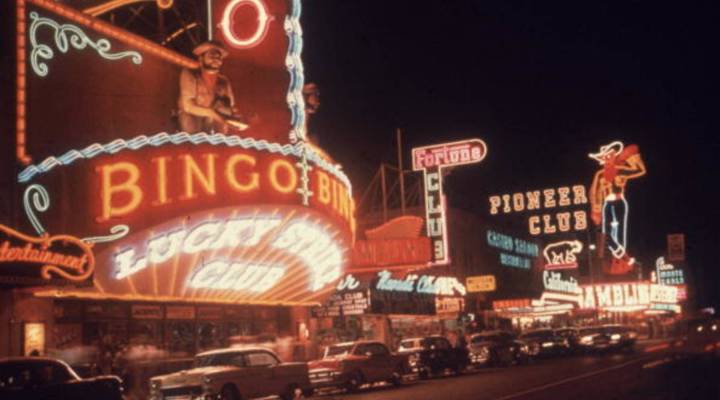
The history of the Las Vegas Strip is the history of how we vacation
The history of the Las Vegas Strip is the history of how we vacation

The buildings on the Last Vegas Strip have changed a lot over the years. But according to architect Stefan Al, if you look past the crap tables and slot machines to the architecture of the Strip, you can see the history of U.S. recreation and social change. Al is a professor of urban design at the University of Pennsylvania and the author of “The Strip: Las Vegas and the Architecture of the American Dream.” Marketplace host Kai Ryssdal spoke with Al about his book; an edited transcript of their interview is below.
Kai Ryssdal: Without taking anything away from the actual writing and the work that’s in this book, the cover and the front-end paper are amazing. Just these representations of the kinds of buildings, the places that were built on the strip, the scale. It’s a little bit archaeological. You know what I mean — going back to, like, 1941?
Stefan Al: Yeah and thanks for that. I actually designed the cover myself. So you know, I’ve literally come back into the archives and dug deep into the floor plans of all the individual casinos when they were first built. And there is a total of 42 really large casinos that were built over the 70-year period, since the Strip was founded. If you trace these, and if you look at the blueprints, if you look over time, there is a clear evolution. Sometimes, you know, casinos try something and then it fails. And then you see that reflected in the next casino. So there’s a very interesting natural evolution that occurs on the strip.
Ryssdal: As the ’50s and ’60s came to pass, it incorporated this idea of gambling into suburbia, right? As Las Vegas grew and thus, sort of, incorporated sin and the American Dream all into one big thing.
Al: Yeah, I think this was really a fascinating period. So after the second World War, a lot of soldiers that returned from the war didn’t move back to the cities. They moved to the suburbs. So there’s a nationwide push for suburbanization. And this American dream that gets manufactured then, is the single-family home. It’s having your own pool. And this is precisely the image that developers then started to hijack. So they built these casinos [in] the shape of a bungalow on steroids with clean modern forms, but also with a pool. And the pool became a really important status symbol for resorts. And they competed with pools. So every new pool had more elaborate shapes. One of the pools, the most famous one in the Sands, had a floating craps table and poolside slot machines.
| A look at a Las Vegas gun shop’s sales |
| A look at the most gambling-addicted states |
Ryssdal: There’s a great picture in the book of that craps table. It’s fabulous.
Al: So, in a way, it rode on the trend. But at the same time, what it did — it encapsulated gambling and this image of suburbia.
Ryssdal: And then just as an indicator of how Vegas continually reinvents itself, there comes a time, like 20-ish years ago, where it becomes “Disneyfied.” And it’s a place you go with your kids for a vacation and wholesome family entertainment.
Al: The Disney Corporation during the time was the world’s largest entertainment corporation. And Vegas developers wanted to tap into this demographic of baby boomers that travel with their children. And as a result, they started to build these larger-than-life Cinderella castles like the Excalibur, which is almost a literal copy of Cinderella Castle. When they found out that families who travel with their children actually don’t spend as much as when they travel without their children — very soon there was a backlash, and all these Disney-style attractions, or a lot of them, were being demolished. And the casinos were redeveloped for the next best thing.
Ryssdal: Which gets us now, in a kind of a roundabout way, to the City Center. And MGM. Which is sort of, I guess, the latest and greatest thing in Vegas now, right?
Al: City Center is the United States’ most expensive private development at $10 billion. And it’s a completely different era in terms of architecture, but also in terms of demographic. They’re no longer going after families but really after millennials. And millennials don’t like to gamble as much as their parents. So they’re giving them other things, like shopping, Broadway shows, nightclubs. It’s really significant how the strip has once again evolved the past 10 years.
There’s a lot happening in the world. Through it all, Marketplace is here for you.
You rely on Marketplace to break down the world’s events and tell you how it affects you in a fact-based, approachable way. We rely on your financial support to keep making that possible.
Your donation today powers the independent journalism that you rely on. For just $5/month, you can help sustain Marketplace so we can keep reporting on the things that matter to you.












